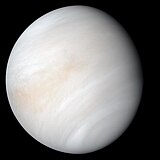Òbrôzk:PIA23791-Venus-RealAndEnhancedContrastViews-20200608 (cropped).jpg
Wygląd

Miara pòdzérkù – 600 × 600 pikslów. Jinszy rozdzélnotë: 240 × 240 pikslów | 480 × 480 pikslów | 768 × 768 pikslów | 1096 × 1096 pikslów.
Pierwòtny lopk (1096 × 1096 pikslów, miara lopka: 30 KB, ôrt MIME: image/jpeg)
Historëjô lopka
Klëkni na datum/czas, abë òbaczëc jak wëzdrzôł lopk w tim czasu.
| Datum/Czas | Miniatura | Miara | Brëkòwnik | Òpisënk | |
|---|---|---|---|---|---|
| aktualny | 00:40, 10 lëp 2020 |  | 1096 × 1096 (30 KB) | PhilipTerryGraham | File:PIA23791-Venus-RealAndEnhancedContrastViews-20200608.jpg cropped 51 % horizontally using CropTool with precise mode. |
Lënczi do lopka
Hewò są starnë, jaczé òdwòłëją sã do negò lopka:
Globalné wëzwëskanié lopka
Nene lopk je téż brëkòwnóny w jinnych ùdbach Wiki:
- Wëzwëskanié w ary.wikipedia.org
- Wëzwëskanié w arz.wikipedia.org
- Wëzwëskanié w ast.wikipedia.org
- Wëzwëskanié w as.wikipedia.org
- Wëzwëskanié w awa.wikipedia.org
- Wëzwëskanié w azb.wikipedia.org
- Wëzwëskanié w az.wikipedia.org
- Wëzwëskanié w ban.wikipedia.org
- Wëzwëskanié w bat-smg.wikipedia.org
- Wëzwëskanié w ba.wikipedia.org
- Wëzwëskanié w bcl.wikipedia.org
- Wëzwëskanié w be-tarask.wikipedia.org
- Wëzwëskanié w be.wikipedia.org
- Wëzwëskanié w bew.wikipedia.org
- Wëzwëskanié w bg.wikipedia.org
- Wëzwëskanié w bh.wikipedia.org
- Wëzwëskanié w bjn.wikipedia.org
- Wëzwëskanié w bn.wikipedia.org
- Wëzwëskanié w bo.wikipedia.org
- Wëzwëskanié w br.wikipedia.org
- Wëzwëskanié w bs.wikipedia.org
- Wëzwëskanié w btm.wikipedia.org
- Wëzwëskanié w bxr.wikipedia.org
- Wëzwëskanié w ca.wikipedia.org
- Wëzwëskanié w cdo.wikipedia.org
- Wëzwëskanié w ceb.wikipedia.org
- Wëzwëskanié w ce.wikipedia.org
- Wëzwëskanié w chr.wikipedia.org
- Wëzwëskanié w ckb.wikipedia.org
- Wëzwëskanié w co.wikipedia.org
- Wëzwëskanié w crh.wikipedia.org
- Wëzwëskanié w cr.wikipedia.org
- Wëzwëskanié w cs.wikipedia.org
- Wëzwëskanié w cu.wikipedia.org
- Wëzwëskanié w cv.wikipedia.org
- Wëzwëskanié w cy.wikipedia.org
- Wëzwëskanié w dag.wikipedia.org
- Wëzwëskanié w da.wikipedia.org
- Wëzwëskanié w de.wikipedia.org
- Wëzwëskanié w dga.wikipedia.org
- Wëzwëskanié w din.wikipedia.org
- Wëzwëskanié w diq.wikipedia.org
- Wëzwëskanié w dsb.wikipedia.org
- Wëzwëskanié w dty.wikipedia.org
- Wëzwëskanié w el.wikipedia.org
- Wëzwëskanié w eml.wikipedia.org
Pòkôżë lëstã glonal;negò brëkwaniô negò lopka.




